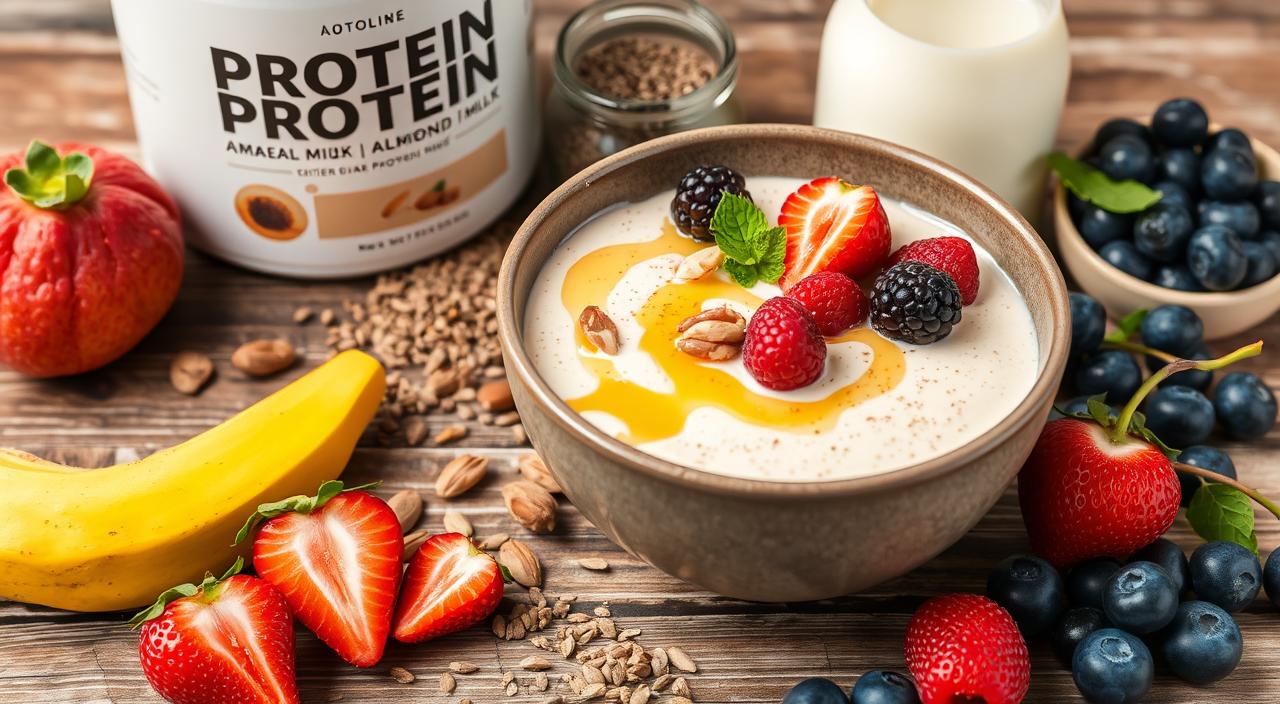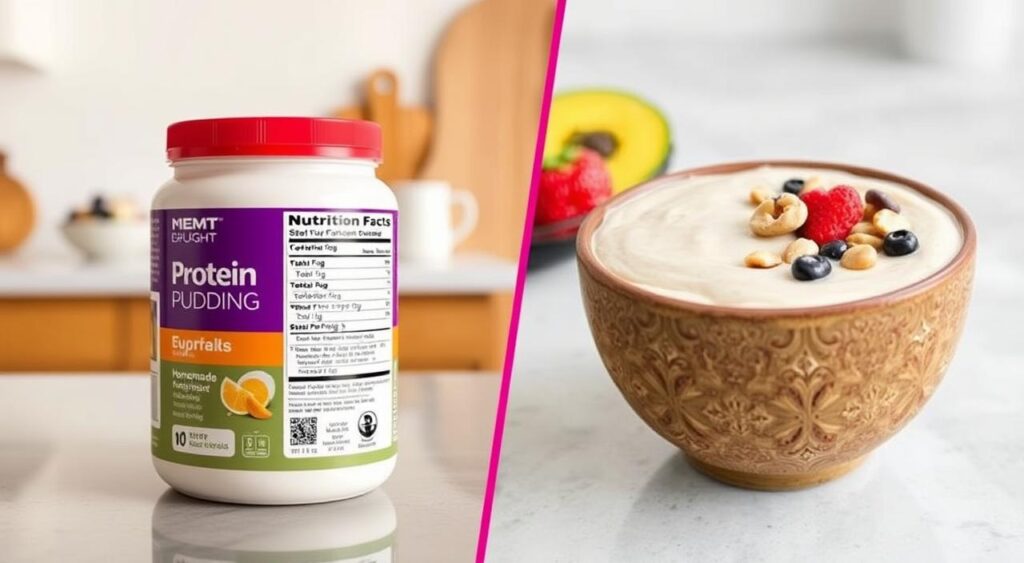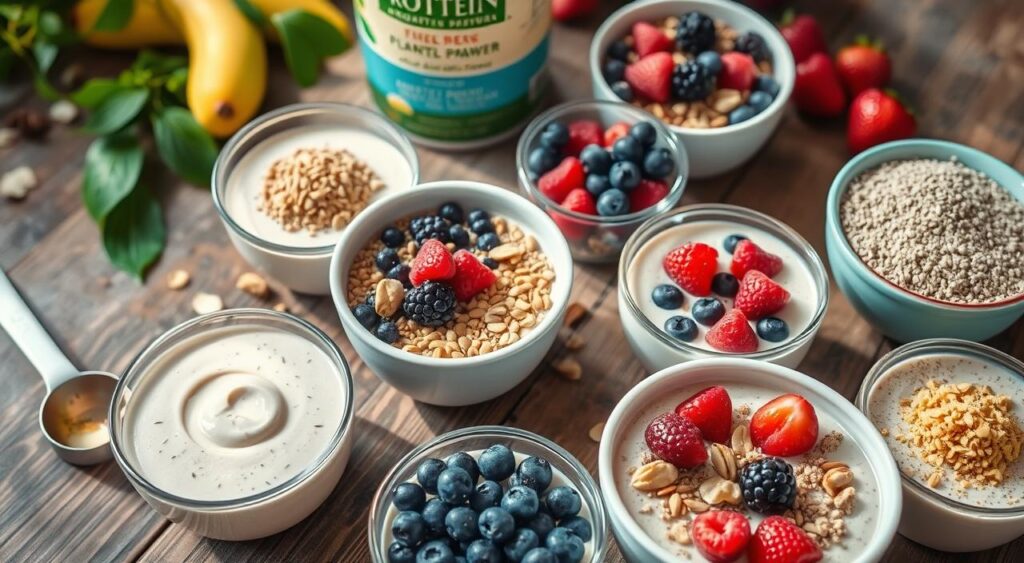Ever craved a tasty dessert that won’t ruin your fitness goals? Protein pudding might be your perfect match. It’s a game-changer that changes how we see healthy snacks.
Protein pudding is more than a sweet treat. It’s a smart way to eat that mixes the comfort of a classic dessert with health benefits. It’s great for athletes, fitness lovers, or anyone looking for a healthy dessert.
Picture enjoying a creamy, tasty dessert that boosts your health. Protein pudding does just that – it gives you important nutrients while pleasing your taste buds. It’s not just a snack; it’s a smart choice that helps you meet your health and fitness goals.
Key Takeaways
- Protein pudding offers a nutritious dessert alternative
- High protein content supports muscle recovery and satiety
- Customizable with various ingredients and flavors
- Supports multiple dietary preferences, including gluten-free options
- Can be a strategic post-workout nutrition choice
Understanding Protein Pudding’s Nutritional Profile
Protein pudding is a tasty mix of dessert and health. It’s a great choice for those who want to eat well but still enjoy sweet treats. This protein dessert turns regular pudding into a nutritional powerhouse.
Key Macronutrients in Protein Pudding
Looking into protein pudding’s nutrition, you’ll find a great mix of macronutrients. A typical serving has:
- 12-15 grams of protein per serving
- Only 103 calories
- Low total fat content (1.7g per serving)
- Minimal sugar content
Essential Vitamins and Minerals
But protein pudding is more than just protein. It’s full of important nutrients for your health:
- Potassium: 200mg per serving
- Sodium: 140mg
- Dietary fiber: 1.8g
Caloric Content Analysis
Compared to other desserts, protein pudding is low in calories. With just 103 calories per serving, it’s perfect for those watching their calorie intake. It’s a great choice for a tasty treat without the guilt.
Protein pudding transforms the concept of dessert from pure indulgence to nutritional strategy.
Adding protein pudding to your diet is a smart move. It’s a balance of taste and nutrition. Whether you’re an athlete, fitness lover, or just looking for healthier options, protein pudding is a delightful choice.
The Benefits of Adding Protein Pudding to Your Diet
Adding high protein pudding to your diet can be a tasty and healthy change. It’s not just a sweet treat. It’s a smart way to meet your nutritional needs and enjoy your food.
Protein pudding has many benefits for your diet:
- Supports muscle recovery after workouts
- Provides a nutrient-dense alternative to traditional desserts
- Helps control appetite and reduce unhealthy snacking
- Offers customizable nutrition for various dietary needs
One big advantage is its help in muscle repair. Protein after exercise can greatly speed up recovery. This makes protein pudding a great snack after working out. The World Health Organization says nutrient-rich foods are key for health.
“Protein pudding isn’t just a dessert – it’s a strategic nutritional tool for health-conscious individuals.”
With about 28 grams of protein and only 165 calories, protein pudding is a great diet addition. Its slow digestion keeps blood sugar stable. This helps avoid hunger and supports long-term diet goals.
Whether you’re an athlete, fitness lover, or just want to eat healthier, protein pudding is a tasty and flexible choice. It meets your nutritional needs in a delicious way.
Common Ingredients in Homemade Protein Pudding
Making a tasty high protein pudding at home is simple. Just a few ingredients can create a nutritious treat that’s good for your fitness goals and sweet tooth.
Choosing the right ingredients is key to a great protein pudding. Let’s look at the main parts that make this dessert both healthy and yummy.
Greek Yogurt: The Perfect Base
Greek yogurt is a top choice for protein pudding. It’s full of protein and probiotics, giving it a creamy texture and lots of health benefits. A cup of Greek yogurt has about 15-20 grams of protein, perfect for your pudding.
Protein Powder Options
- Whey protein: Fast-absorbing and great for muscle recovery
- Casein protein: Slow-releasing protein for sustained nutrition
- Plant-based proteins: Ideal for vegan and lactose-intolerant individuals
Natural Sweeteners and Flavorings
Add natural sweeteners and flavors to make your protein pudding taste amazing. Here are some ideas:
- Maple syrup (1-3 tablespoons)
- Cocoa powder for chocolate lovers
- Vanilla extract
- Stevia for zero-calorie sweetness
“The secret to a great protein pudding is balancing nutrition with flavor!” – Nutrition Expert
Making your protein pudding takes less than 2 minutes with a blender or food processor. You can keep it in the fridge for 3-4 days. It’s a quick and healthy snack.
Store-Bought vs. Homemade Protein Pudding
Choosing between store-bought and homemade protein pudding has its pros and cons. Let’s look at the main differences that might sway your decision.
Nutritional Comparison
Homemade protein pudding is a nutritional powerhouse. It has 57 grams of protein per serving, compared to store-bought’s 19 grams. The homemade version also has:
- 317 calories per serving
- 9 grams of carbohydrates
- 4.6 grams of fat
Ingredient Quality
Store-bought puddings often have artificial sweeteners and extra additives. But, your homemade protein pudding can be made with just two ingredients: Greek yogurt and protein powder. This way, you know exactly what you’re eating.
“Control your nutrition by making protein pudding at home” – Fitness Nutrition Expert
Convenience and Customization
Making your own protein pudding is quick, taking less than 2 minutes. You can try different flavors like:
- Chocolate protein pudding
- Vanilla protein dessert
- Fruit-infused variations
Your homemade pudding can be kept in the fridge for up to 3 days. It’s perfect for meal prep. The recipe works with many protein powders, including whey, casein, and vegan options. This gives you lots of flexibility.
Best Types of Protein Powder for Pudding Making
Choosing the right protein powder is key to making the best high protein pudding. The type you pick can change how your pudding tastes, feels, and what it does for your body.
There are many kinds of protein powders, each with its own special qualities for your pudding. Knowing what makes them different helps you make the perfect pudding.
Whey Protein Advantages
Whey protein is a top pick for high protein pudding. It’s smooth and absorbs quickly, making it great for creamy desserts. Here are some benefits:
- Fast-absorbing protein profile
- Smooth, consistent texture
- Complete amino acid composition
- Excellent for muscle recovery
Plant-Based Protein Options
If you don’t eat dairy, plant-based proteins are great alternatives. They work well in pudding but might need some recipe tweaks:
- Pea protein
- Brown rice protein
- Hemp protein
- Slightly different mixing requirements
Casein Protein Considerations
Casein protein makes your pudding thicker and more filling. It takes longer to digest than whey, giving you protein over time. It’s perfect for a more satisfying pudding.
Pro tip: Experiment with different protein powders to find your perfect pudding consistency!
Most protein powders have about 54 grams of protein per serving. This makes them a great choice for a healthy dessert.
Creative Protein Pudding Flavor Variations
Turning your protein pudding into something special is simple. Fans of protein desserts can explore many tasty flavors. These keep the treat exciting and fulfilling.
Here are some delicious protein pudding variations to try:
- Classic Chocolate Dream: Mix chocolate protein powder with cocoa for a deep chocolate taste
- Vanilla Bean Delight: Use vanilla protein powder and add real vanilla extract for extra flavor
- Cinnamon Crunch Sensation: Sprinkle cinnamon and crushed graham crackers for a fun texture
- Strawberry Cheesecake Twist: Blend strawberry protein powder with cream cheese for a creamy mix
- Cookie Dough Indulgence: Add sugar-free cookie dough flavoring for a sweet treat
- Cookies and Cream Magic: Crush sugar-free chocolate cookies into your protein pudding for a crunchy surprise
“Creativity turns a simple protein pudding into a gourmet dessert experience.”
Try mixing different protein powder flavors and add-ins to find your favorite. Remember, start with small batches. This way, you can test new flavors without wasting anything.
Protein Pudding as a Post-Workout Snack
After a tough workout, your body needs good nutrition to recover and grow muscles. High protein pudding is a great choice for this. It’s quick, tasty, and packed with protein.
What you eat after working out is key for muscle repair and growth. Protein pudding gives your body the nutrients it needs right when it’s most important.
Recovery Benefits
Protein pudding is a big win for athletes:
- It has 57 grams of protein per serving
- Helps fix muscle tissue
- Gives your body quick nutrients
- Ready in just 2 minutes
Timing Your Protein Intake
Eating your protein dessert within 30 minutes after working out is best. It has whey and casein proteins. These provide quick and lasting amino acids for your muscles.
“Nutrition is the foundation of muscle growth and recovery” – Sports Nutrition Experts
Protein pudding is also super flexible. You can add things like cocoa powder or peanut butter. This makes your recovery snack both healthy and fun.
Health Considerations and Dietary Restrictions
Making a high protein pudding for different diets can be tough but doable. It helps those with food allergies, special diets, or nutritional needs. Protein pudding is a flexible choice for many.
For those with dietary restrictions, consider these key adaptations:
- Lactose-free alternatives using plant-based milk
- Vegan protein pudding options with plant-based proteins
- Low-sugar formulations for diabetes management
- Gluten-free ingredient selections
People with lactose intolerance can enjoy protein pudding with dairy-free options. About 65% of the world’s population has lactose sensitivity. Non-dairy milk like almond, soy, or oat milk works well instead of dairy.
Protein pudding isn’t just a treat—it’s a nutritional powerhouse that can be customized to meet individual health requirements.
To control sugar intake, choose natural sweeteners or sugar substitutes. Most protein puddings have 10 to 20 grams of protein per serving. Look for low-carb and low-sugar options. But, be careful of artificial sweeteners as they might upset some stomachs.
If you have specific health concerns, talk to a nutritionist. They can help find the best protein pudding for your needs.
Making Protein Pudding Part of a Balanced Diet
Adding protein pudding to your daily meals can be tasty and smart. It’s a great choice for those looking for a healthy treat. It helps support your health and fitness goals.
Portion Control Guidelines
Knowing how much protein pudding to eat is important. Here are some tips:
- Aim for 1/2 to 1 cup per serving
- Track total daily protein intake
- Consider your individual nutritional needs
- Balance protein pudding with other nutrient sources
“Moderation is the key to enjoying protein pudding while maintaining a balanced diet.” – Nutrition Expert
Meal Planning Tips
Planning your meals can make protein pudding even better. Here are some ideas:
- Use protein pudding as a post-workout recovery snack
- Replace high-calorie desserts with this protein-rich alternative
- Pair with fresh fruits or nuts for added nutrition
- Rotate protein pudding with other protein sources
A typical serving of protein pudding has about 15-20 grams of protein. This makes it a great way to boost your protein intake. Just remember to adjust your other protein sources to keep your diet balanced.
With the right planning and portion sizes, protein pudding can be a wonderful addition to your meals. It’s both delicious and good for you.
Storage Tips and Meal Prep Strategies
Preparing your high protein pudding ahead of time can save you a lot of time. It ensures you always have a healthy dessert ready. The right storage methods help keep your pudding fresh and tasty all week.
Here are some important tips for storing your protein pudding:
- Refrigerate in an airtight container
- Consume within 3-4 days for optimal taste and texture
- Use sealed glass or plastic containers with tight-fitting lids
Pro tip: Divide your high protein pudding into individual portion containers for easy grab-and-go meals.
“Meal prep is about making healthy eating convenient and sustainable” – Nutrition Experts
If you want to store your pudding for longer, freezing is a good option. Here’s how to freeze it:
- Use freezer-safe containers
- Leave some space at the top for expansion
- Freeze for up to 4 months
- Thaw in the refrigerator overnight before consuming
Using these storage tips, you can enjoy your protein pudding all week. It stays delicious and nutritious. Meal prepping your pudding saves time and helps you reach your health and fitness goals.
Who Should Consider Adding Protein Pudding to Their Diet
Protein pudding is more than just a trendy snack. It’s a nutritional powerhouse for many. It’s great for athletes, fitness lovers, or anyone wanting to eat better. This high protein pudding could be your new go-to.
Athletes and fitness fans will love protein pudding. It has about 20-30 grams of protein per serving. This helps muscles recover and reduces hunger after working out. Studies show eating enough protein after exercise can boost muscle recovery by 22%.
- Individuals seeking weight management
- People wanting healthier dessert alternatives
- Those needing increased protein intake
- Vegetarians looking for protein-rich options
Older adults and those with special diets can also benefit from protein pudding. It has very little sugar, usually under 5 grams per serving. This is good for those watching their sugar. The high protein helps keep muscle mass, which decreases with age.
“Protein pudding delivers a combination of protein, healthy fats, and carbohydrates which can maintain steady energy levels” – Nutrition Experts
For those trying to lose weight, protein pudding is a smart snack. High-protein diets can cut daily calorie intake by 400-500 calories. This tasty treat is a smart choice for your diet.
Conclusion
Exploring protein pudding shows it’s a tasty and healthy dessert choice. It’s quick to make and packed with 14g of protein per serving. This makes it perfect for those who want a nutritious treat.
Protein pudding is great for busy women and fitness fans. It uses full-fat cottage cheese and cacao powder for extra nutrients. Plus, it has only 4g of net carbs, ideal for those watching their carb intake.
Making your own protein pudding lets you tailor it to your taste. You can pick your protein powder and sweeteners. This way, you get a dessert that’s both delicious and good for you.
Think of protein pudding as more than just a dessert. It’s a smart choice for boosting protein, managing weight, or enjoying a sweet treat without guilt. It’s a wonderful part of a balanced diet.
FAQ
What exactly is protein pudding?
Protein pudding is a healthy dessert or snack. It’s made with protein powder, like Greek yogurt or milk. It’s creamy and can be flavored in many ways, helping you reach your fitness goals.
How much protein does a typical protein pudding contain?
A typical protein pudding has 15-25 grams of protein. This is great for meeting your daily protein needs and helping muscles recover.
Is protein pudding suitable for weight management?
Yes, it’s great for weight management. Its high protein content makes you feel full, helping you lose weight while keeping muscles.
Can I make protein pudding if I’m lactose intolerant?
Absolutely! Use lactose-free options like plant-based yogurts or almond milk. There are many vegan and lactose-free choices for different diets.
How long can I store homemade protein pudding?
Store it in an airtight container in the fridge for 3-5 days. For the best taste and texture, eat it within 2-3 days. Always check for spoilage before eating.
What are the best protein powders for making protein pudding?
Choose from whey, casein, or plant-based proteins like pea or hemp. Pick based on your goals and taste preferences.
Is protein pudding good for post-workout nutrition?
Yes, it’s perfect for post-workout. It’s high in protein, supports muscle recovery, and is easy to digest. It’s great for replenishing nutrients after exercise.
Can diabetics consume protein pudding?
Diabetics can enjoy it by choosing low-sugar options and using sugar-free sweeteners. Always check with a healthcare professional to make sure it fits your diet.
Are there any allergen concerns with protein pudding?
Yes, there are potential allergens like dairy, soy, and nuts. Always read labels and choose ingredients that fit your dietary needs or allergies.
How can I make protein pudding more interesting?
Try different flavors like chocolate or vanilla. Add mix-ins like fruits, nuts, or sugar-free chocolate chips. This will make your protein pudding fun and tasty.



